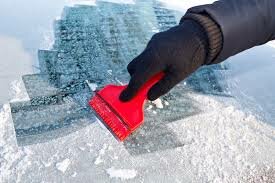-
 Get the right kind of oil change. Are you approaching the time for a 30,000-mile full service for your vehicle? If so, don’t procrastinate! Among other things, the service should include an oil change, and the oil used should have the right viscosity, or thickness, for your vehicle at this time of year. Oil tends to thicken as it gets colder, and if it’s too thick it won’t do the best job of keeping your engine lubricated. Check your owner’s manual for guidance about which oil to use in different climates and temperatures.
Get the right kind of oil change. Are you approaching the time for a 30,000-mile full service for your vehicle? If so, don’t procrastinate! Among other things, the service should include an oil change, and the oil used should have the right viscosity, or thickness, for your vehicle at this time of year. Oil tends to thicken as it gets colder, and if it’s too thick it won’t do the best job of keeping your engine lubricated. Check your owner’s manual for guidance about which oil to use in different climates and temperatures. - Make sure you can see. When’s the last time you replaced your windshield wiper blades? They usually work effectively for about one year, so be sure to invest in some new ones if you’re due. Here’s another important step to take before you find yourself struggling to see in a blinding storm: Fill up your windshield washer reservoir with windshield washer fluid. (Plain water won’t do the trick at this time of year because it freezes.) Also check to see that your heater and defroster are working properly so you can keep the windshield nice and clear.
- Give your battery a little TLC. This is an ideal time of year to make sure your battery’s posts and connections are corrosion-free and that your battery has all the water it needs. If your battery is more than three years old, have a certified repair shop test its ability to hold a charge. Granted, you might be able to find a Good Samaritan to help you jump-start your vehicle in the middle of a blizzard — but wouldn’t you rather avoid such a scenario altogether?
- Examine your belts and hoses. When you have that full service done on your vehicle, make sure the belts and hoses get checked for wear and tear — even if you’re driving a modern car. Cold weather can do a number on belts and hoses, so they deserve attention.
- Check your tire pressure. Your tires must be properly inflated to ensure you’ll have the best possible traction as you drive along — and traction is often severely jeopardized in wet, snowy or icy conditions. The air pressure in your tires has likely dropped as the weather has gotten colder, so it’s important to see where things stand now. (You can generally expect that you’ll lose 1 pound per square inch whenever the temperature drops by 10 degrees Fahrenheit.) Again, your trusty owner’s manual will tell you what your target tire pressure should be.
- Think about switching to snow tires. Do you live in a hilly place that gets its fair share of snow? Then you might want to improve traction even more by investing in winter tires and using them over the next few months instead of your usual all-season tires. When shopping around for snow tires, ask about all the fees that might come into play, such as fees for mounting and balancing. You can accomplish this easily and make accurate cost comparisons by asking each store for the “out the door charge.”
- Do you have four-wheel drive? If so, it’s important to check the status of your four-wheel-drive system and be sure it’s working correctly — especially because most drivers don’t use their 4WD systems in the pleasant summer months. Be sure that the system engages and disengages easily, and that all drivers in your household know how and when to activate the system.
- Get the antifreeze mixture just right. Aim for having a 50-50 mix of antifreeze (coolant) and water inside your radiator. This will prevent the mixture from freezing even at ridiculously cold temperatures. It’s easy to check the status of the mixture with an inexpensive antifreeze tester, which you can pick up at any auto parts store. If the mixture is off, your cooling system should be drained and refilled or flushed. Be sure you’re equipped to dispose of your old antifreeze properly if you do this job yourself. It can’t just be poured down the drain.
-
Prepare an emergency kit. Store this stuff in your trunk during the winter months, especially if a road trip is in your future:
- a blanket
- extra boots and gloves
- an extra set of warm clothes
- extra water and food, including hard candies
- an ice scraper
- a small shovel
- a flashlight
- windshield washer fluid
- windshield wipers
- flares
- jumper cables
- a tool kit
- tire chains
- a tire gauge
- a spare tire with air in it
- tire-changing equipment
- a first-aid kit
- paper towels
- a bag of abrasive material such as sand, salt or non-clumping kitty litter, which can provide additional traction if a tire gets stuck in snow.
- Also, keep the gas tank as full as you can to prevent the gas lines from freezing.
Winterize Your Car
By eMetro Times | on November 12, 2014 | 0 Comment
Author Description
Recent Posts
-
Heritage High School Patriot Players Put a New Twist on Les Miserables
January 15, 2025 - 0 Comment -
It’s Proposal Season! Weddings Away from Home
January 14, 2025 - 0 Comment -
Pet of the Month…Maggie
January 14, 2025 - 0 Comment
eMetro Times Photos
|
Sunday 01/15 0%
Mostly Cloudy
Partly cloudy skies this morning will become overcast during the afternoon. High 73F. Winds light and variable.
|
|
|
Monday 01/16 50%
Chance of Rain
Mostly cloudy in the morning then periods of showers later in the day. High 68F. Winds light and variable. Chance of rain 50%.
|
|
|
Tuesday 01/17 20%
Fog
Morning fog, then mostly cloudy in the afternoon. A stray shower or thunderstorm is possible. High 71F. Winds S at 5 to 10 mph.
|




















No Responses to “Winterize Your Car”